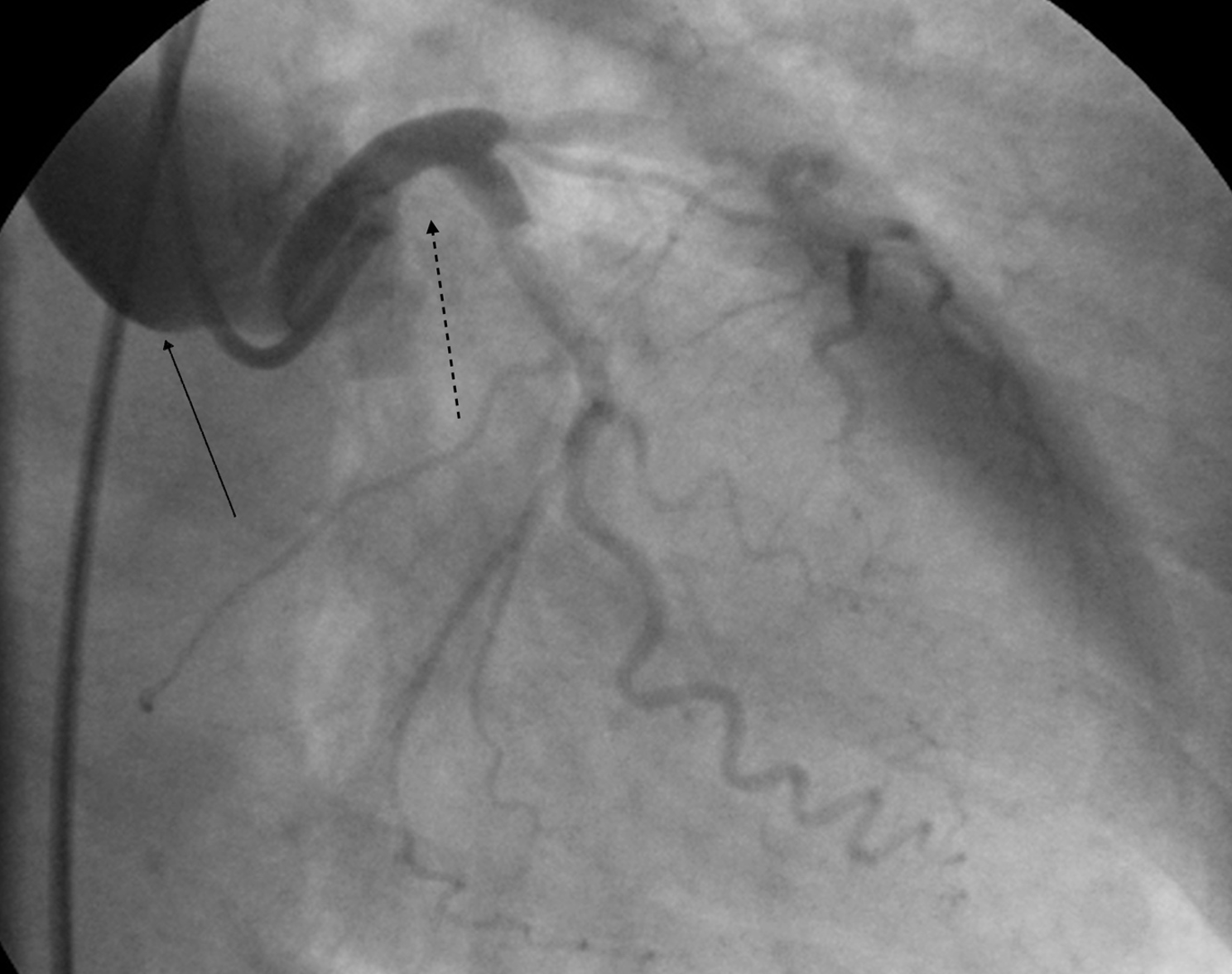Type A aortic dissection during therapeutic coronary intervention in acute coronary syndrome: case report
Main Article Content
Abstract
Iatrogenic aortic dissection during coronary interventions is a rare complication and has heterogeneous management in the reviewed literature. We report a case of acute aortic syndrome of traumatic etiology, during a percutaneous coronary procedure, with its management, intra-hospital evolution, and one-year follow-up. A 65-year-old female who, during a percutaneous coronary intervention, presented an endothelium trauma of the left main artery's aorta-ostial transition by the tip of the guide catheter, leading to aortic dissection and occlusion of the left main artery with hemodynamic deterioration of the patient. The left main artery's flow was restored with drug-eluting stent implantation leading to a successful sealing of the false lumen with consequent hemodynamic stabilization. Immediate post-procedure transthoracic echocardiography showed a competent aortic valve. The patient evolved favorably and remains asymptomatic after one year.
Article Details
Authors maintain copyright and grant the HSJ the right to first publication. From 2024, the publications wiil be licensed under Attribution 4.0 International 
 , allowing their sharing, recognizing the authorship and initial publication in this journal.
, allowing their sharing, recognizing the authorship and initial publication in this journal.
Authors are authorized to assume additional contracts separately for the non-exclusive distribution of the version of the work published in this journal (e.g., publishing in an institutional repository or as a book chapter), with acknowledgment of authorship and initial publication in this journal.
Authors are encouraged to publish and distribute their work online (e.g., in institutional repositories or on their personal page) at any point after the editorial process.
Also, the AUTHOR is informed and consents that the HSJ can incorporate his article into existing or future scientific databases and indexers, under the conditions defined by the latter at all times, which will involve, at least, the possibility that the holders of these databases can perform the following actions on the article.
References
Erbel R, Aboyans V, Boileau C, Bossone E, Di Bartolomeo R, Eggebrecht H, et al. 2014 ESC guidelines on the diagnosis and treatment of aortic diseases. Eur Heart J. 2014;35(41):2873-926. https://doi.org/10.1093/eurheartj/ehu281 DOI: https://doi.org/10.1093/eurheartj/ehv178
Carter AJ, Brinker JA. Dissection of the ascending aorta associated with coronary angiography. Am J Cardiol. 1994;73(12):922-3. https://doi.org/10.1016/0002-9149(94)90830-3 DOI: https://doi.org/10.1016/0002-9149(94)90830-3
Moles VP, Chappuis F, Simonet F, Urban P, De La Serna F, Pande AK, et al. Aortic dissection as complication of percutaneous transluminal coronary angioplasty. Cathet Cardiovasc Diagn. 1992;26(1):8-11. https://doi.org/10.1002/ccd.1810260103 DOI: https://doi.org/10.1002/ccd.1810260103
Shorrock D, Michael TT, Patel V, Kotsia A, Rangan BV, Abdullah SA, Grodin JM, Banerjee A, Brilakis ES. Frequency and outcomes of aortocoronary dissection during percutaneous coronary intervention of chronic total occlusions: a case series and systematic review of the literature. Catheter Cardiovasc Interv. 2014;84(4):670-5. https://doi.org/10.1002/ccd.25338 DOI: https://doi.org/10.1002/ccd.25338
Doutriaux M, Pariente B, Zahnan J, Marchand X. Conservative Treatment of Iatrogenic Ascending Aortic Hematoma Post-Rotablator Coronary Procedure. Thorac Cardiovasc Surg Rep. 2020;9:47-50. https://doi.org/10.1055/s-0040-1715431 DOI: https://doi.org/10.1055/s-0040-1715431
de Barros e Silva PG, Aquino T, Resende MV, Richter I, Barros CM, Andrioli VG, Baruzzi AC, Medeiros CC, Furlan V. Resolution of an acute aortic syndrome with aortic valve insufficiency post-PCI. Am J Case Rep. 2014;15:508-13. https://doi.org/10.12659/AJCR.891301 DOI: https://doi.org/10.12659/AJCR.891301
Hagan PG, Nienaber CA, Isselbacher EM, Bruckman D, Karavite DJ, Russman PL, et al. The International Registry of Acute Aortic Dissection (IRAD): new insights into an old disease. JAMA. 2000;283(7):897-903. https://doi.org/10.1001/jama.283.7.897 DOI: https://doi.org/10.1001/jama.283.7.897
Fiddler M, Avadhani SA, Marmur JD. Guide catheter-induced aortic dissection complicated by pericardial effusion with pulsus paradoxus: a case report of successful medical management. Case Rep Med. 2015;2015:480242. https://doi.org/10.1155/2015/480242 DOI: https://doi.org/10.1155/2015/480242
Sekiguchi M, Sagawa N, Miyajima A, Hasegawa S, Yamazaki M, Kurabayashi M. Simultaneous right and left coronary occlusion caused by an extensive dissection to the coronary sinus of valsalva during percutaneous intervention in right coronary artery. Int Heart J. 2009;50(5):663-7. https://doi.org/10.1536/ihj.50.663 DOI: https://doi.org/10.1536/ihj.50.663
Yip HK, Wu CJ, Yeh KH, Hang CL, Fang CY, Hsieh KY, et al. Unusual complication of retrograde dissection to the coronary sinus of valsalva during percutaneous revascularization: a single-center experience and literature review. Chest. 2001;119(2):493-501. https://doi.org/10.1378/chest.119.2.493 DOI: https://doi.org/10.1378/chest.119.2.493
Carstensen S, Ward MR. Iatrogenic aortocoronary dissection: the case for immediate aortoostial stenting. Heart Lung Circ. 2008;17(4):325-9. https://doi.org/10.1016/j.hlc.2007.11.140 DOI: https://doi.org/10.1016/j.hlc.2007.11.140
Dunning DW, Kahn JK, Hawkins ET, O'Neill WW. Iatrogenic coronary artery dissections extending into and involving the aortic root. Catheter Cardiovasc Interv. 2000;51(4):387-93. https://doi.org/10.1002/1522-726X(200012)51:4<387::AID-CCD3>3.0.CO;2-B DOI: https://doi.org/10.1002/1522-726X(200012)51:4<387::AID-CCD3>3.0.CO;2-B
Park I-W, Min P-K, Cho D-K, Byun K-H. Successful endovascular treatment of iatrogenic coronary artery dissection extending into the entire ascending aorta. Can J Cardiol. 2008;24(11):857-9. https://doi.org/10.1016/S0828-282X(08)70196-X DOI: https://doi.org/10.1016/S0828-282X(08)70196-X
Boukhris M, Tomasello SD, Marzà F, Azzarelli S, Galassi AR. Iatrogenic Aortic Dissection Complicating Percutaneous Coronary Intervention for Chronic Total Occlusion. Can J Cardiol. 2015;31(3):320-7. https://doi.org/10.1016/j.cjca.2014.11.030 DOI: https://doi.org/10.1016/j.cjca.2014.11.030
Núñez-Gil IJ, Bautista D, Cerrato E, Salinas P, Varbella F, Omedè P, et al. Incidence, management, and immediate- and long-term outcomes after iatrogenic aortic dissection during diagnostic or interventional coronary procedures. Circulation. 2015;131(24):2114-9. https://doi.org/10.1161/CIRCULATIONAHA.115.015334 DOI: https://doi.org/10.1161/CIRCULATIONAHA.115.015334
